Quagmire Tiarello Couldn’t Be Better by Mylisa Larsen; Clarion, 2024.
Quag is dealing with a lot, and he’s holding it all inside. He bluffs his way through peer relationships, hiding behind a detached facade while struggling to maintain his home life as his mom’s mental health spins out of control.
“Story is a human need, a way to make sense of our lives, our communities, our dreams, and our relationships. It’s a catalyst for our imaginations and for healing, learning, connecting, and so much more.”
~ Kaela Noel
Why read aloud?
We gather to share a book. We settle into a safe space as we interact with the book. We talk and reflect, exchanging thoughts, exploring concepts, building background knowledge—and community. When read-aloud sessions are routine, children become comfortable voicing their perspectives. They grow in active listening skills and learn to respect the thoughts, feelings, experiences, and beliefs of others. When we (educators, parents, and caregivers) select age-appropriate, length-appropriate stories based on needs and abilities, we offer children the opportunity to see themselves, see others, find validation, and contemplate solutions to conflicts and challenges that they may not have considered.
Read-aloud sessions are inclusive: there is no reading skills or level barrier, and learning obstacles are mitigated by preparation prior to reading the book aloud. In a read-aloud session there is immersion as well as the comfort of distance from the challenges the characters encounter.
Reading aloud engages listeners, offering a positive, secure, stress-free “learning without struggle” experience grounded in a book, the value of which cannot be overestimated.
“You think your pain and your heartbreak are unprecedented in the history of the world, but then you read. It was books that taught me that the things that tormented me most were the very things that connected me with all the people who were alive, or who had ever been alive.” ~ James Baldwin
Why this book? Why will it matter to kids?
Millions of people in the U.S. are affected by mental illness each year. As the National Alliance on Mental Illness (NAMI) points out, “it’s important to measure how common mental illness is so we can understand its physical, social, and financial impact” — and so we can support those who have a mental illness or those who care for someone who does. The challenges of living with mental illness and maintaining recovery impact families, communities, and our world. Young people who experience mental illness personally or through a loved one’s illness can benefit from informational books as well as stories that help them see that they are not alone and empower them by providing possible coping options and avenues of support.
Levels and Layers of Learning
Grade level: 6-8
Social-Emotional Learning Themes
Acceptance, compassion, concern, connection, conservation, courage, creativity, curiosity, dedication, empathy, empowerment, encouragement, fortitude, friendship, generosity of spirit, gratitude, generosity of spirit, hope, inspiration, integrity, kindness, loyalty, perspective, resilience, respect, responsibility, relationship skills, self-assurance, self-awareness, self-management, self-reliance, social awareness, understanding
Content Area Connections: Social-Emotional Learning, English Language Arts, Science, Theater and Performing Arts
Using This Book in the Classroom
Hit the Ground Running Ready Resources for Educators, Homeschoolers, and Parents
Mylisa Larsen explains how to pronounce her first name:
“My darling parents made it up. Which is fine. But then they decided to pronounce it differently than they spelled it and everyone, everyone, everyone has been confused ever since. Even my own grandma. It’s pronounced to rhyme with Teresa: So, Muh LEE suh.”
Coming Soon: Discussion Guide for Quagmire Tiarello Couldn’t Be Better. Check the Resources page on Mylisa’s website.
Write Away! Ideas to prompt writing
Quagmire is a kid who is sometimes annoying to his friends, but he is also creative and capable of doing amazing things. Do you know someone like Quagmire? Write about that person, describing him or her in detail (you don’t need to reveal a name).
What do you like best about Quagmire? What do you like least? Explain.
Thinking about Quagmire and the challenges he faces in this story, how might you help a friend who is struggling with difficulty at school or at home? The author, Mylisa Larsen, offers suggestions in her author’s note at the back of the book. Which do you think would be most helpful to a friend of yours? Which would you feel most comfortable doing? What else might you suggest?
Authors often choose names for their characters that will help define them to readers. Mylisa Larsen, the author of Quagmire Tiarello Couldn’t Be Better, chose to name her main character Quagmire, and in the story (pages 142-43) she explains how he got that nickname. Look up the meaning of the word, quagmire. Do you think this is a good name for the main character? Explain.
What is your favorite scene in the book? Why?
See also Mylisa’s suggestions for student discussions in the interview segment of this post.
Poetry Break Related poetry to recite before or following the reading of this book
Poetry breaks fit perfectly into the framework of the school day. These brief moments can signal change, smooth or frame transitions—from beginning or ending the day to lining up for lunch; from zipping up backpacks and jackets to shifting from one subject to the next. Poetry breaks can reset mood or tone, providing a moment to pause, reflect, and breathe. Reading a poem aloud typically takes less than a minute, yet it can introduce or reinforce a concept, provide clarity, celebrate language, exemplify rhythm, enhance vocabulary, expand understanding, increase attention span, initiate reflection, spark imagination, or simply summon a giggle. And, poetry soothes and strengthens the spirit.
“Poetry builds resilience in kids and adults; it fosters Social and Emotional Learning. A well-crafted phrase or two in a poem can help us see an experience in an entirely new way.” ~ Elena Aguilar
Poetry to share in the season of thanksgiving (which ought to be year-round):
- It’s Thanksgiving by Jack Prelutsky, illustrated by Marylin Hafner
- Thanku: Poems of Gratitude edited by Miranda Paul, illustrated by Marlena Myles
- We Are Grateful by Traci Sorell, illustrated by Frané Lessac; also available in a board book set
And Then There’s This…
Enrichment activities, related books, online resources, craft projects, and ideas for further study
Mental Health Resources:
- www.NAMI.org offers a variety of resources including webinars and podcasts for those interested in learning more about mental health through personal stories, advice and research, and strategies for those seeking support.
- Call or text 988 to speak confidentially with a crisis counselor.
- 988lifeline.org is the online option.
- NAMI offers a Kids, Teens and Young Adults Resource Directory and helpline that connects those seeking support with young people with similar experiences.
- Additional resources for teens compiled by Mylisa can be found on her website.
Book Collection Suggestions
Books for middle graders that center on mental illness and/or challenging home life situations:
- All the Greys on Greene Street by Laura Tucker
- Before the Ever After by Jacqueline Woodson
- Breathing Underwater by Sarah Allen
- Chasing the Milky Way by Erin E. Moulton
- Each Tiny Spark by Pablo Cartaya
- Faker by Gordon Korman
- Fighting Words by Kimberly Brubaker Bradley
- Friends Forever by Shannon Hale
- Ghost by Jason Reynolds
- Hey, Kiddo by Jarrett Krosoczka
- Keeping the Night Watch by Hope Anita Smith, illustrated by E. B. Lewis
- The Last Tree Town by Beth Turley
- The List of Things That Will Not Change by Rebecca Stead
- Nest by Esther Ehrlich
- Ordinary Hazards by Nikki Grimes
- The Science of Breakable Things by Tae Keller
- So B. It by Sarah Weeks
- Someone Else’s Shoes by Ellen Wittlinger
- The Space Between Before and After by Sue Stauffacher
- The Stars Beneath Our Feet by David Barclay
- Stuntboy, in the Meantime by Jason Reynolds
- Things You Can’t Say by Jenn Bishop
- Trowbridge Road by Marcella Fleischman Pixley
- The Year We Fell from Space by A. S. King
- Where the Watermelons Grow by Cindy Baldwin
- Words with Wings by Nikki Grimes
See also:
Reading Middle Grade: “50+ Books About Mental Illness” in which books are categorized by whether the parents have a mental illness, or the kids struggle with a mental health issue.
“Mental Health in Middle Grade Books” An Interview with Cindy Baldwin, author of Where the Watermelons Grow: Sarah’s Smorgasbord post includes lists of books for kids concerning mental health.
Have a title to suggest? Scroll down to add it in the Comments section at the end of this post.
Meet the Author

Mylisa Larsen
Mylisa Larsen is the author of the novels Quagmire Tiarello Couldn’t Be Better and Playing Through The Turnaround, and the picture books All Of Those Babies, If I Were A Kangaroo, How To Put Your Parents to Bed, and Ho Ho Homework. She has lived in Idaho, New York, Minnesota, Michigan, Iowa, California, Arizona, Utah, Texas, and Brazil and she has loved things about all of those places. The first thing she always finds is the library. Visit her online to learn more.
Backstory: Q & A with Mylisa Larsen
I have known Mylisa for years, as we both have participated in the Rochester Children’s Book Festival and taken part annually in Festival-to-Go in various Rochester, NY city schools. I have always admired her intelligence, her sense of humor, her writing acumen, and her commitment to creating the best children’s books possible. You’ll see what I mean as you read her thoughtful, thorough responses to my questions—despite how many there are! I found so much to talk about concerning this timely novel for middle schoolers, and I appreciate that Mylisa graciously answered them all. I’m delighted to welcome Mylisa Larsen to Children’s Book Corner.
Judy Bradbury: Tell us about this project: What seeded its creation?
Mylisa Larsen: I’m so intrigued by the kids I’ve worked with over the years who didn’t make things easy, who had an attitude, who gave no quarter. Often, when I hung in there long enough to get through some of the walls and learn their stories, they’d end up being some of my favorite people. So I kind of wanted to show what might be behind that kid who is sometimes a pain but who might be doing some amazing things offstage.
JB: Though not exactly a sequel, this novel follows Playing Through the Turnaround, where the characters Quagmire and Cassie are introduced. When and why did you decide to write a book in which Quag would be the main character?
ML: I just felt that Quag was the one kid who didn’t really get to tell his story in Playing Through The Turnaround. And his story kept knocking on the door—even though I didn’t really know what that story was. I just knew that something was going on with Quag’s mom, but wasn’t sure what.
JB: Factual birding segments and audio files from Quagmire’s phone are randomly interspersed between chapters. How did you conceive of the novel’s structure?
ML: I’m not good at plot. (Okay, I’m terrible at plot.) There’s a lot of thrashing around during the first draft trying to figure out what should happen. So you’ll often see me using some kind of structural device to get at the story. And I do love structural things that let the reader kind of play along–trying to figure out “what does this have to do with the story.”
I had a chapter early in the book where Quag lies to Cassie about being a birder. And in order to keep her from discovering that this was a lie, Quag is having to learn more than he wants to about birds. And I was talking to a friend during the thrashing stage about was there anything I could do structurally with these birds, and we talked for awhile but couldn’t quite figure it out.
But she kept thinking after we got off the phone and the next morning texted me “ooh! I bet birds keep themselves safe in different ways (camouflage, attack, deception, etc.)” and I was like, “YES!” Because that is so Quag. All this stuff he does is just trying to keep himself safe. So then the bird facts became a way for Quag to subconsciously reflect what is going on in his own life. And the audio files are a game I’m playing with the reader—here’s where Quag is physically and here’s what he’s noticing and recording—and I hope it’s a nice surprise what happens to the audio files in the end.
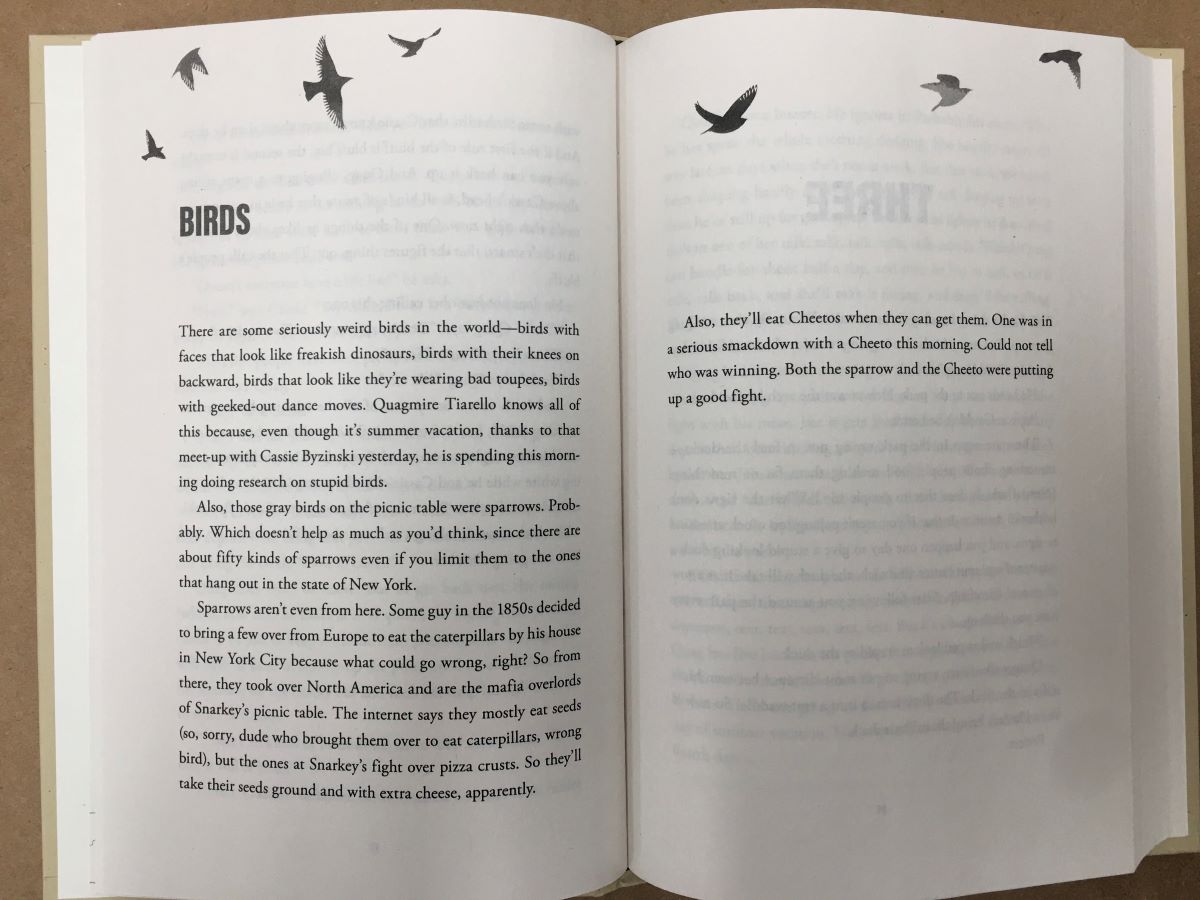
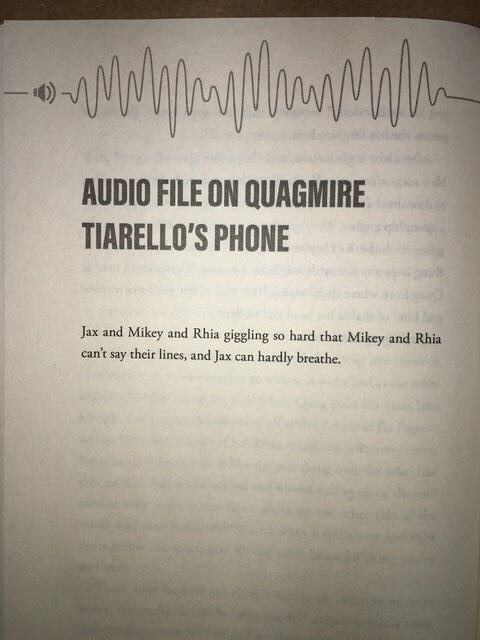
Interior design by Chris Kwon and Jessie Gang
JB: Tell about one hurdle you experienced in the creation of Quagmire Tiarello Couldn’t Be Better, or provide a memorable (or humorous!) anecdote related to the writing of the novel.
ML: I got the first version of Quagmire’s story past some very tough beta readers on style points, I think. And then it was acquired. And then my brilliant editor basically said something like, “Great character, nice writing but it’s only about a third of a book. So you’ll need to write the other two thirds.” And I was like, “WHAT?” But she was absolutely right.
JB: What is one unexpected joy that came from the creation of Quagmire Tiarello Couldn’t Be Better?
ML: I think the unexpected joy during Quag was that because I struggled so much in the drafting, I figured out how to be less alone while writing. I had been more of a lock myself in a tower kind of writer. I’d check in with writing friends when I needed to know if something was working but it was a lot of “I’ll see you all when this is finished.” But that wasn’t an option this time. I had two thirds of a story to write and I had a deadline and I didn’t know what happened in this story. So I talked to everyone–about structure, about plot, about anything I thought could help. There was one point when I was so stuck that I called together a little group of smart writing friends who knew Quag and once a week for three weeks we had Save The Quag brainstorming sessions where we just tried to think about what might happen for Quag going forward that felt authentic. And it was so helpful to me. People are so generous. I knew that but I really felt it during the writing of this one.
JB: What would surprise readers to learn about you or about the writing of Quagmire Tiarello Couldn’t Be Better?
ML: I don’t know if this will surprise anyone else, but it always surprises me how little control I seem to have over my characters. I invented them. You’d think I could just make them do whatever I decide they should do. But that is not how it works for me. I always feel like I’m banging around in a dark room trying to find the light switch and figure out what on earth is going on with this character.
JB: Since I am from the Buffalo, NY area and an iconic hot dog brand local to our area is featured briefly but memorably in the novel, I have to ask: how and why did you decide to include Ted’s Hot Dogs in the story?
ML: Scenes need stages to play out on. I wanted something uniquely Buffalo for when Quag and his mom were passing through. But I wrote this particular part of the story during the lockdown portion of the pandemic so I couldn’t drive to Buffalo and check places out. So I asked the internet what were some iconic places in Buffalo. Ted’s was one of the things that came up and when I saw some of the pictures and read the reviews and the menu, I thought, “Perfect.”
JB: Who do you perceive your target audience to be and why?
ML: I wrote Quagmire for any kid who feels like they are holding up a whole lot of their world and wonders if it’s always going to be like this. I wrote it for the students and teachers who notice those kids who aren’t always easy to be around and question why. I wrote it for all of us who love someone who has a mental health condition. And all of us who have a mental health condition ourselves and have perhaps come up against some less than helpful ways of thinking about that.
JB: What do you hope readers will take away from Quagmire Tiarello Couldn’t Be Better?
ML: That we all need help sometimes. That it’s okay to admit that. That there are people who will help and they’re worth finding.
JB: What need(s) does this story satisfy?
ML: I hope it helps people look at kids who aren’t easy in a more empathetic way; there’s often a reason. I hope it portrays Quag’s mom as the difficult, fun, brave, full person that she is. I hope it helps people have honest conversations about mental health. But I also hope that it’s got enough humor to be a fun read. Life is sad and funny and happy and all the things intermixed and I wanted to write a book with all of those things in the same book.
JB: If you could ask your readers one question, what would it be?
ML: What’s something you need help with and who are you going to ask to help you?
JB: How do you see Quagmire Tiarello Couldn’t Be Better connecting to curriculum or being used in schools or learning settings?
ML: I think English teachers are going to have better answers to this than I will but here are a few thoughts: 1) I think this is an accessible text, but these bird and audio file segments add a kind of complexity and could make for some good class discussion. What do the students think these sections are about? How do they relate to the rest of the story? Are there other ways the author could have done what these sections do? What might those be? 2) I hope it becomes a door for an honest discussion of mental health and what’s helpful when we’re struggling and what’s not helpful. 3) I hope in an SEL way, it can be an entry point for talking in a realistic way about knowing when you need help with something that’s gotten too big for you to handle on your own.
Books written by Mylisa Larsen

Sidebar Spotlight New releases of note
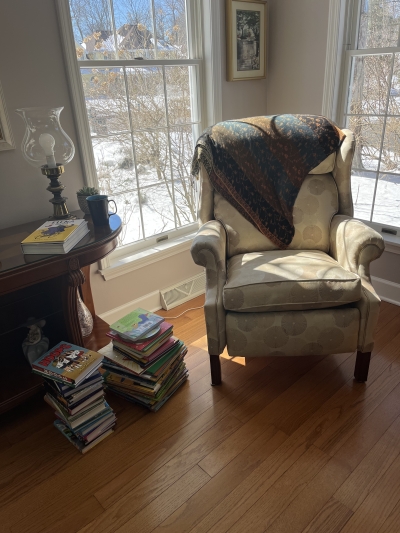
Each month I receive several boxes of books to review from various publishers. As I read and peruse the books, I place them in two piles: those that I will consider featuring on the blog, and those that don’t fit the mission or theme of Children’s Book Corner blog for whatever reason. I highlight some of the books in the “possible” pile on Mondays (most weeks) on Instagram. Ultimately, I choose the one new release I will feature on my monthly blog post. Yet there are many terrific books I wish I could give a shout-out to, even if I can’t write an entire post about each one. So, Sidebar Spotlight is a means of giving a nod to new releases that, in my opinion, are noteworthy. I’ve linked each title to Bookshop so you can learn more. Happy reading, friends! And feel free to comment on these or other new books below.
Addy McBean Numbers Queen by Margery Cuyler and illustrated by Stacy Curtis is pure fun perfectly pitched for newly independent readers. Addy loves math and she finds it everywhere from the number of times her dog’s tail wags to the numbers project with her less-than-ideal partner. Includes a word list and discussion questions.
Author Visit Jitters by Julie Danneberg, illustrated by Judy Love is the latest in the popular, school-centered picture book series. Read to find out who the special guest author is in this ideal read-aloud with colorful illustrations that are bursting with delightful details. Find an interview with the author and more about her books on this previous Children’s Book Corner post.
Thank You by Jarvis is my pick to add to my Thanksgiving read-aloud list and to keep on my shelf of gratitude books to recommend year-round. From nighttime through the following day and full circle back to a starry night, this busy child is full of energy, spirit, and gratitude. Grades K-2.
News, Updates, & Items of Interest
I’m looking forward to kicking off the holiday season with Rustic Buffalo at a fun event on Friday, November 15th at the Kenan Center in Lockport, NY! I’m happy to return to the city where I taught for several years to talk with folks and sign books, which we all know make great gifts! If you’re in the area, stop by. See you there!

Learn more about where my books and I will be on my Events page.
I am currently booking school visits and professional development sessions for 2024-25.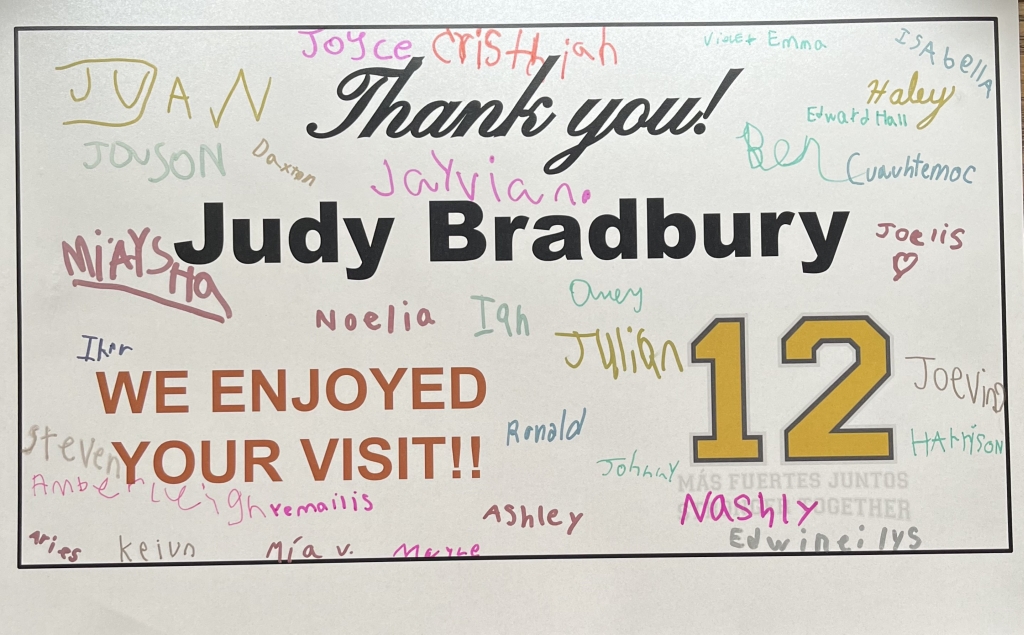
Find information and contact me to discuss a visit tailored to meet your school’s needs.
A note from a teacher whose students I recently visited:
Thank you so much for coming to meet with my students. You were wonderful, answering their questions and explaining how you wrote the book. We all loved it! Here are some illustrated thank you notes the students made for you. Thank you again!
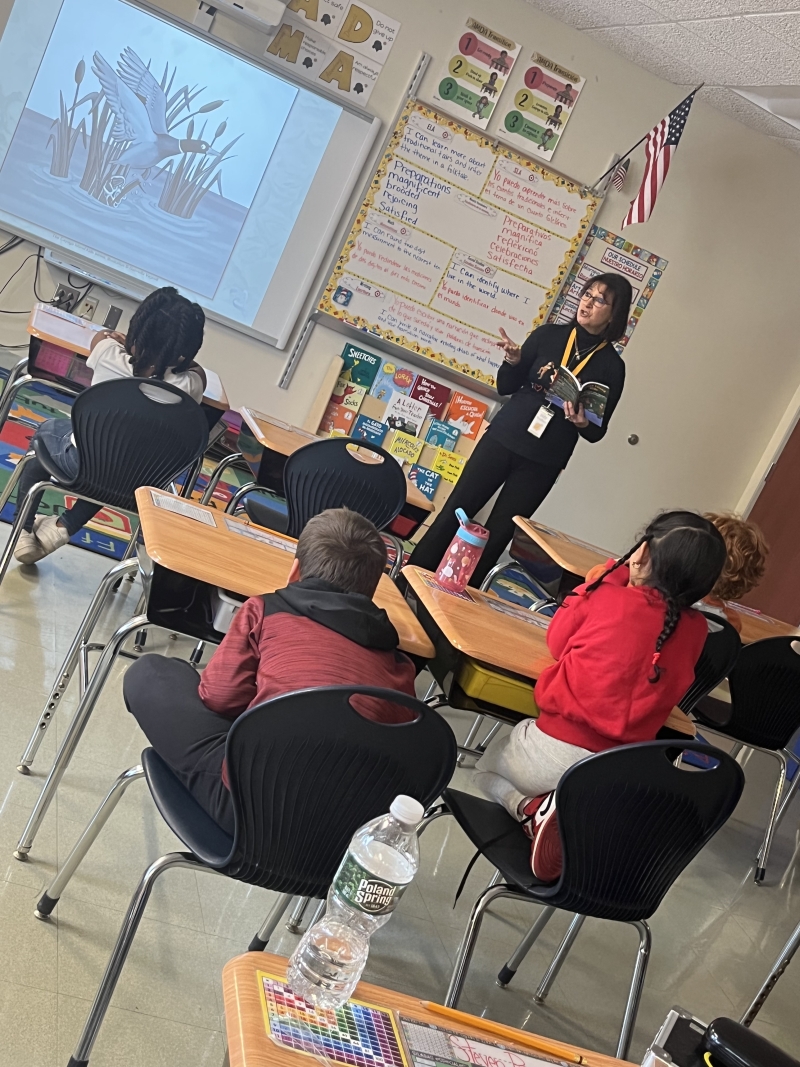
Read-aloud of a portion of Cayuga Island Kids Book 2, The Adventure of the Big Fish by the Small Creek
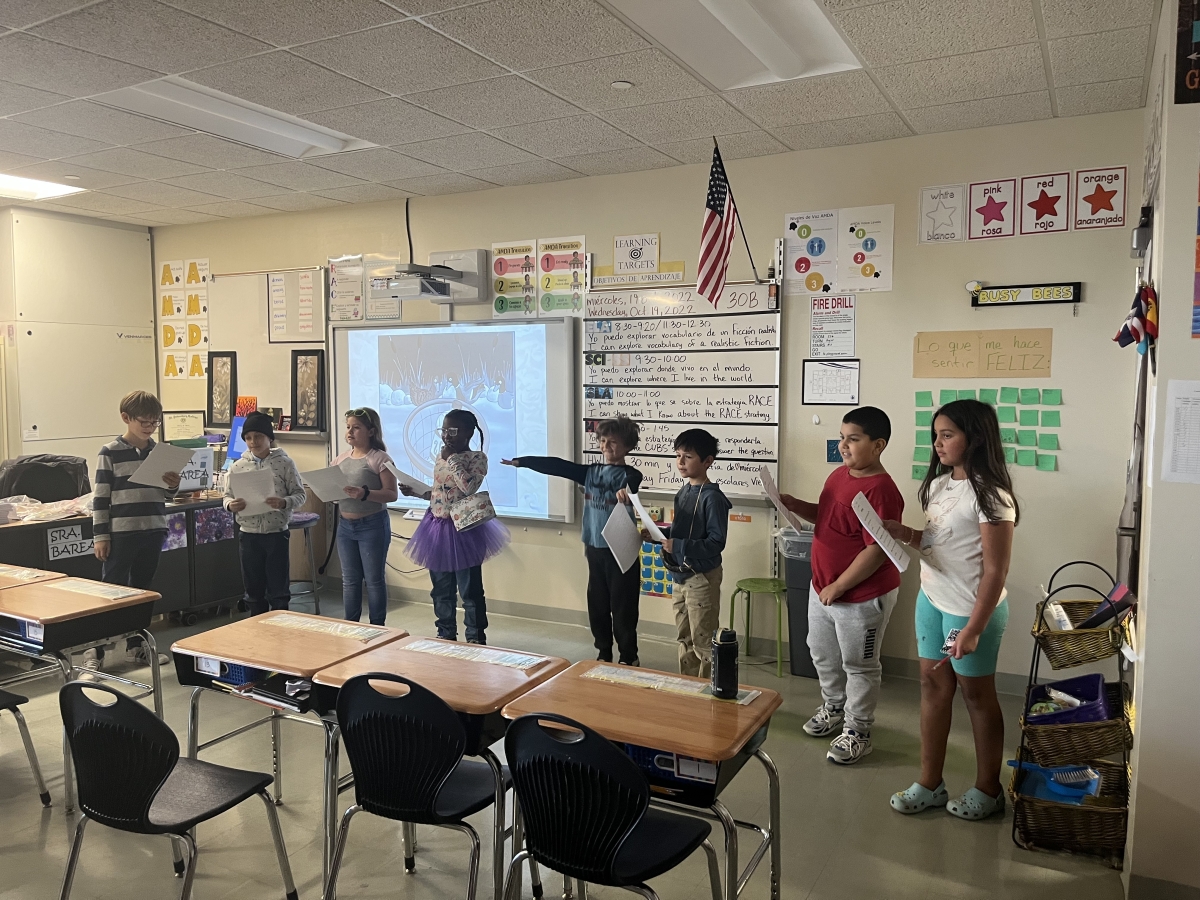
Readers Theater, complete with props!
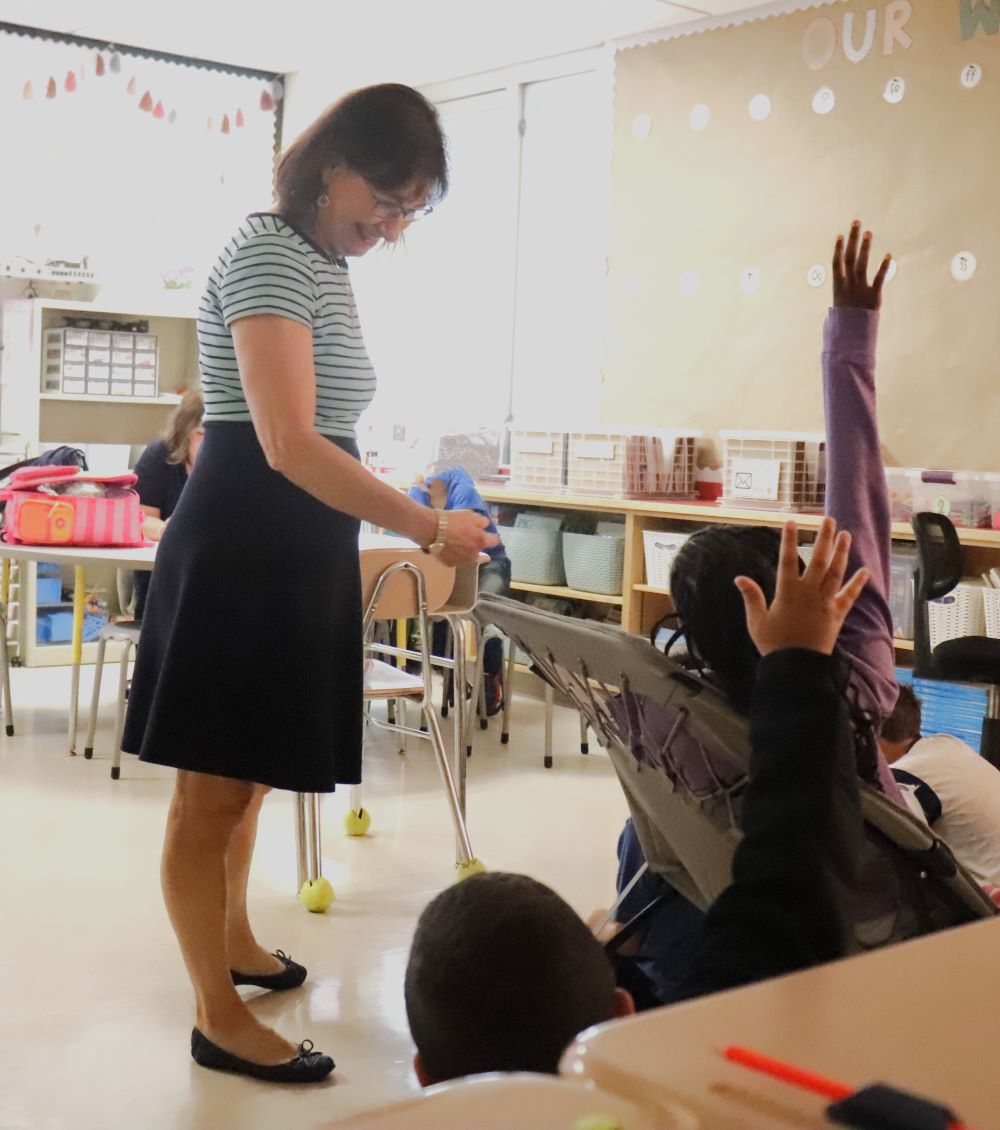
And here’s a note I received after presenting “SEL-Related Children’s Books with Curriculum Tie-Ins” to teachers and librarians in Grades Pre-K—Grade 6:
Thanks so much for presenting! I heard wonderful things about your workshop! One person mentioned to me that you were so organized and passionate. They also loved seeing all the children’s books you brought with you!
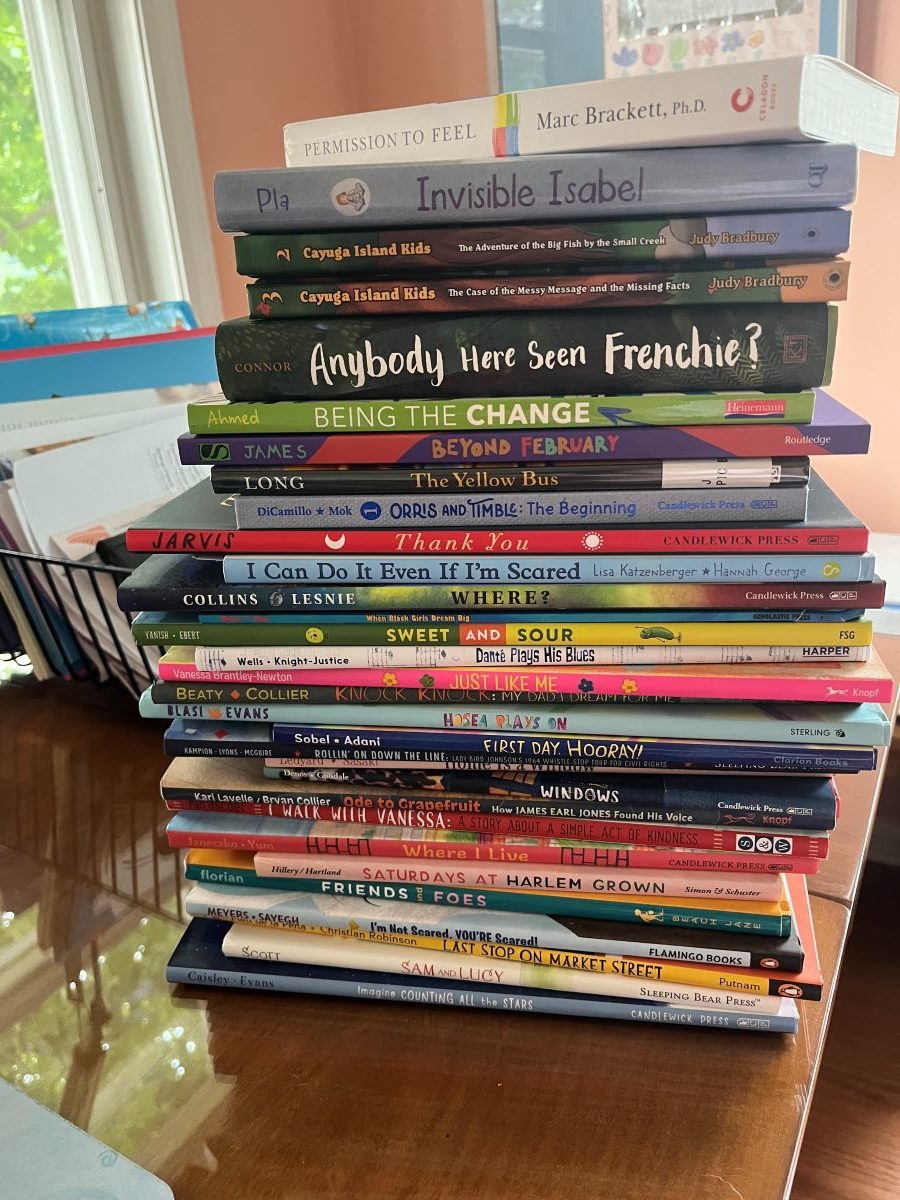
Find my books packaged as a series at your favorite bookshop or purchase directly from the publisher and receive a gift with purchase! Individual titles are also available in hard, softcover, and e-book versions.
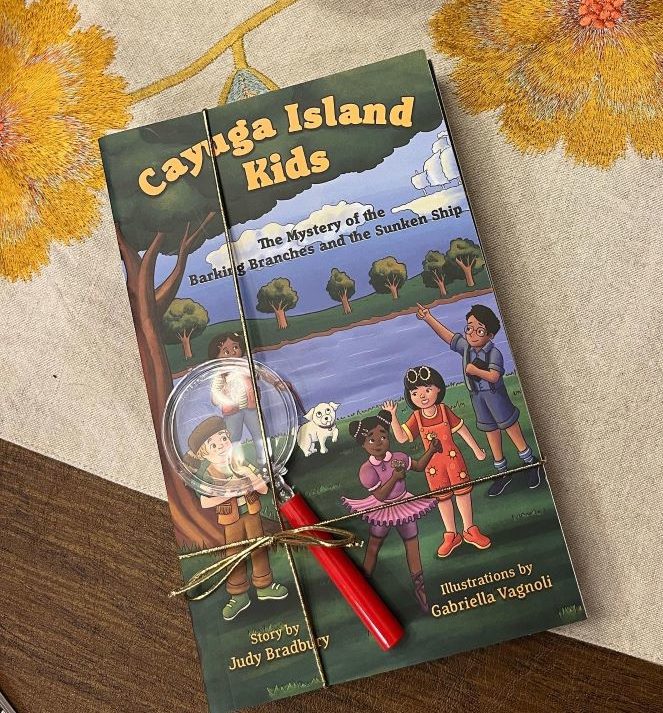
Kindness tip: If you read and like a book, consider posting a review on GoodReads, social media, or on Amazon (if you bought it there). Authors and illustrators appreciate the shout-out. Even a one-sentence comment increases visibility of a book. Also consider placing a request with your local library to purchase a copy–another free way to support a book you recommend!
Over to You…
Join the conversation! Offer your thoughts on this featured prompt related to this month’s post:
What middle grade book centering on dealing with mental illness do you recommend? Share the title and author in the comments section.
You are also welcome to post a general comment.
Thanks for sharing your thoughts!
Final Thought
“[Books] assured me that there were other people out there whose lives were also scary and complicated.”
~ Laurie Halse Anderson

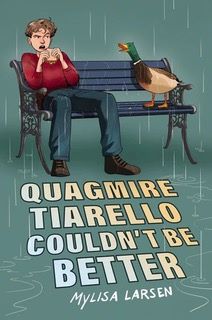
Well, how embarrassing! I’ve known Mylisa for years, and she’s never told me I’ve been mis-pronouncing her name all this while! Thank you, Judy, for clearing that up. Meanwhile, I bought a bunch of books at the Rochester Children’s Book Festival, and I’ve just now started reading this one. I love it already. Mylisa does such a great job of having her kids talk and think like kids–smart, funny kids with real problems, pains, hopes, and distinct personalities. Well done, Mylisa! And, Judy, I hope your wonderful blog brings attention to this excellent book.
Well, how embarrassing! I’ve known Mylisa for years, and she’s never told me I’ve been mis-pronouncing her name all this while! Thank you, Judy, for clearing that up. Meanwhile, I bought a bunch of books at the Rochester Children’s Book Festival, and I’ve just now started reading this one. I love it already. Mylisa does such a great job of having her kids talk and think like kids–smart, funny kids with real problems, pains, hopes, and distinct personalities. Well done, Mylisa! And, Judy, I hope your wonderful blog brings attention to this excellent book.
Hah, don’t be embarrassed, Vivian! You are not alone in mispronouncing Mylisa’s name, and doesn’t this just confirm how gracious and kind this fabulous author is not to correct those of us who messed it up? 🙂
I’m glad you enjoyed the post and understand completely about loving Mylisa’s book from its beginning pages. Thanks for sharing, Vivian.
I am definitely adding this one to my “to read” list! I, too, am drawn to these challenging kids and their hidden stories. And I just loved reading about Mylisa’s process in writing this, about the control her characters usurp in the telling of the story, and how very challenging it can be to understand your characters and build a plot around them! Thanks for sharing.
I completely agree, Deb, and I am confident you will enjoy reading this book, not only for the excellent story, but also with a writer’s eye for how Mylisa’s creative talent allowed the characters to shine.